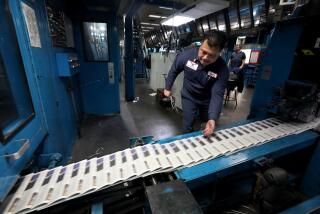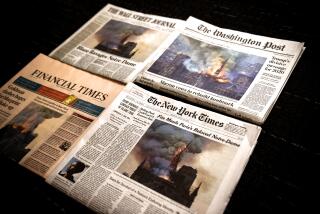A case of wartime deja vu
- Share via
SHORTLY before he was killed in an auto accident earlier this week, David Halberstam and I discussed some points we hoped to cover in an onstage conversation we would have had Thursday evening, at a dinner sponsored by the Jewish Federation of Greater Los Angeles.
Our hosts had been particularly generous concerning the scope of our chat, but David and I quickly agreed that the topic that seemed most urgent to both of us was how the conflicts in Iraq and Vietnam have come to resemble each other in fundamental ways.
Halberstam had made his reputation as one of his generation’s greatest reporters by providing the New York Times’ readers with coverage of the war in Southeast Asia that recorded the facts on the ground rather than the convenient official fantasies about what was occurring as tens of thousands of Americans and hundreds of thousands of Vietnamese died. His book on the origins of America’s enmeshment in Southeast Asia, “The Best and the Brightest,” remains not simply the finest account of that process but also -- by implication -- a definitive study of how an elite foreign policy establishment’s hubris worked to undercut American altruism and farsightedness in the prosecution of the Cold War.
“Both wars, of course, are quagmires,” Halberstam said in that improbable baritone that rumbled over the phone line like the voice of God on steroids. “The facts on the ground are different, but I’m afraid the facts in Washington are not. In both Vietnam and Baghdad, you have American governments constructing their policies out of mendacity and delusion, and young men and women are dying for that lethal combination.”
Halberstam’s synthesis of the Bush administration’s failings in Iraq seemed precisely to the point Friday, in news accounts concerning former Director of Central Intelligence George J. Tenet’s forthcoming book recounting the White House’s willful distortion of the facts in the run-up to the invasion of Iraq. According to the New York Times on Friday, Tenet alleges that President Bush and his vice president, Dick Cheney, not only were resolved to invade Iraq no matter what intelligence reports actually showed but also that Cheney in particular was determined to assert that there was a link between Saddam Hussein and Al Qaeda, when none ever existed.
In other words, “mendacity and delusion” -- and people dying as a consequence.
Halberstam’s appraisal was supported further this week by testimony given to Los Angeles Democrat Henry Waxman’s House Committee on Oversight and Government Reform, which is inquiring into two of the more sordid examples of official duplicity with regard to the wars in Iraq and Afghanistan. In the case of Afghanistan, the committee heard from the family of former National Football League star Pat Tillman, who walked away from a multimillion-dollar contract to enlist in the Army Rangers after 9/11.
When Tillman was killed fighting in Afghanistan, the military fabricated a story -- and a fictional official report that earned him a posthumous Silver Star -- about his heroics in the firefight that took his life. To their everlasting credit, Tillman’s family refused to accept the military’s duplicitous account of that day and pressed until the facts emerged: Pat Tillman was killed by friendly fire. When his family persisted in demanding the truth about Pat Tillman’s death, one of the Army officers involved told them that their lack of Christian faith made them unwilling to accept his death.
In other words, lies compounded by official insult.
The other star witness to appear before the House committee was former Army Pvt. Jessica Lynch, the young woman from West Virginia who was captured by Hussein’s forces during the invasion and later rescued by her U.S. Army colleagues. A military in desperate need of celluloid-style heroes and heroines, to satisfy the administrations’ demand for salable stories, subsequently fabricated an imagined account of her as a kind of female Rambo.
In her testimony this week, Lynch was having none of that. Here’s what she told Waxman’s committee this week: “I believe this is not a time for finger pointing,” she said. “It is time for the truth, the whole truth, versus misinformation and hype.”
Lynch’s testimony reinforced another of the points Halberstam hoped to make in our public conversation. Early in the Iraq war, a number of commentators -- and most particularly the London Daily Telegraph’s John Keegan, the distinguished military historian who went a little gaga over the campaign to overthrow Hussein -- repeatedly wrote that the Pentagon’s program of embedding correspondents with military units would create a generation of journalists sympathetic to the military, as opposed to the Vietnam-influenced correspondents lost to cynicism about the efficacy of a martial foreign policy.
Halberstam found Keegan’s assertions frankly silly and, listening to Lynch’s congressional testimony this week, would have found support for his views.
Another of the points on which Halberstam hoped to touch in our talk was whether American newspapers and television networks are willing to go on paying to do the kind of journalism that makes it possible to acquaint readers and viewers with government actions.
As the war in Iraq has gone on year after grinding year, the number of U.S. news organizations willing to foot the bill to maintain full-time correspondents in Baghdad has dwindled. As David Lauter, The Times’ deputy foreign editor, said this week, “Given how expensive it is and how difficult, it’s a pretty big commitment for those organizations which have stuck with it. I think now you’ve gotten down pretty much to the hard core of organizations which feel that covering Iraq is at the center of what we do and simply can’t be abandoned.”
The Times doesn’t release figures on how much it costs to maintain a staff in Iraq, but the figure is somewhere around $1.5 million yearly, plus the correspondents’ salaries.
That’s a significant number, given the fact that over the last four months, American news organizations have laid off 4,391 journalists, a 93% increase over the 2,271 put on the street during the first quarter of last year. (The Times said this week that it will reduce its overall staff by 150 by June 1, and as many as 70 of those people will be eliminated from the news operation.)
Halberstam was acutely concerned about the effect the economic assumptions behind such cuts would have on newspaper journalists’ ability to bring to light our government’s propensity for deadly “mendacity and delusion.” Had he had the opportunity to speak in Los Angeles this week, he might well have echoed something he said in a talk in Tennessee last year:
“The industry as a whole is in trouble because people at the top are taking out too much money and driving the profits up. The perception is that the real customers are not those who read the paper but those who buy the stock. It damages the profession.”
More to Read
Sign up for our Book Club newsletter
Get the latest news, events and more from the Los Angeles Times Book Club, and help us get L.A. reading and talking.
You may occasionally receive promotional content from the Los Angeles Times.






